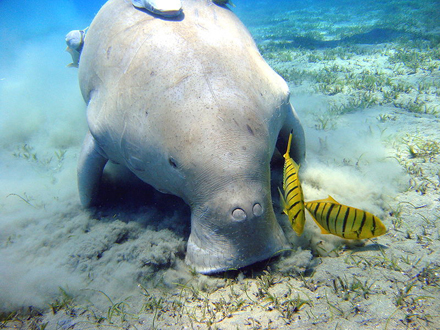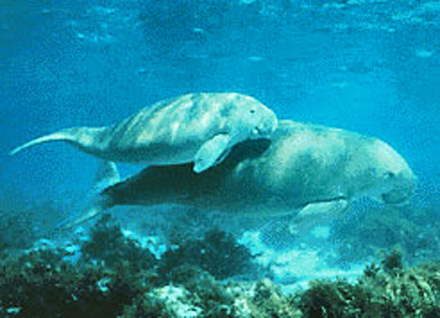Navigation
International Efforts Save Dugongs
Dugongs are believed to have been at the origin of mermaid legends when spotted swimming in the water from a distance. Now the remaining populations of this seemingly clumsy sea mammal, commonly known as a sea cow, are at serious risk of becoming extinct within the next 40 years.
 |
| A Dugong near Marsa Alam (Egypt).Photograph by Julien Willem from Wikipedia. |
Dugongs are believed to have been at the origin of mermaid legends when spotted swimming in the water from a distance. Now the remaining populations of this seemingly clumsy sea mammal, commonly known as a sea cow, are at serious risk of becoming extinct within the next 40 years.
At an international meeting this week on dugongs convened by the Convention on the Conservation of Migratory Species of Wild Animals (UNEP/CMS) in Abu Dhabi, Governments, international and non-governmental organizations and experts discussed solutions to protect the world’s only herbivorous mammal living in marine waters.
CMS Executive Secretary Elizabeth Maruma Mrema said: “Simple innovative tools and new incentives for local fishermen have been presented to the signatories to the CMS dugong agreement, which might prevent this rare species from becoming extinct.”
A newly developed innovative toolbox to mitigate threats to dugongs includes incentives to replace harmful gillnets with alternative fishing gear to reduce by-catch and minimize the mortality rates.
According to an assessment undertaken in 2008, the dugong is now extinct in the Maldives, Mauritius and Taiwan, and declining in other waters in at least a third of the areas where it is found. However, at present, information on the dugongs is too limited to even assess completely the threats.
Man-made threats pose the greatest risk to the gentle sea cow. Illegal poaching, unsustainable hunting by local communities, severe injuries from ships and vanishing seagrass beds are accelerating a critical loss of habitat and threatening populations.
 |
| Dugong (Dugong dugon) The dugong inhabits the tropical and subtropical coastal and island waters in the Indo-Pacific from East Africa to Vanuatu, between 26ºN and 26ºS latitudes. It is a member of the order Sirenia, which also includes three species of manatees (see the previous section) and is the only member of the family Dugongidae. Although the dugong is an herbivorous animal like the manatee, it is strictly marine. Large distances often separate dugong stocks, thought to be relict populations, although the animal is known to be able to traverse vast expanses of ocean. Human exploitation has led to extinction of the species in several archipelagoes, including Mascarene, Laccadive, the Maldives, Barren, Narcondam, Cocos (Keeling), and Christmas Islands around the rim of the Indian Ocean, and the Lesser Sunda Islands in Indonesia east of Java. Dugong's may live for more than 70 years. Text and photograph from the US Marine Mammal Commission |
The use of gillnets has led to the incidental entanglement in fishing gear, which is also a major threat. As fisheries become increasingly commercialized, by-catch will become even more frequent and serious. The second largest threat is unsustainable direct consumption which can result once a dugong is caught in the nets. In addition, dugongs are also legally hunted by local communities in some countries for traditional consumption.
Risks from man-made threats are exacerbated by the dugong’s low reproduction rates. Even the slightly reduced survival rate of adults as a result of habitat loss, disease, hunting or drowning in nets can trigger a dramatic decline.
Initiating and enhancing regional cooperation among the countries that host dugong populations is essential to ensure the survival of this unique marine mammal.
Data from fishermen surveyed in 20 countries in the Pacific Islands, South Asia as well as the United Arab Emirates are now available and will be reviewed to assess the threat of fishing on the survival of the dugongs in parts of its migratory range. The data will be combined into a geographical information system to identify the trouble spots, provide crucial information on existing populations and map important habitat areas such as seagrass beds.
The data from the surveys will also help complete missing information on areas where threats to the dugong might be very high and enable local communities to preserve critical habitat. In 2011, the survey will be extended to countries in East Africa and the western Indian Ocean islands,
the northwestern Indian Ocean as well as South Asian regions.
Other solutions that seek to protect valuable dugong habitat as well as breeding and feeding areas include establishing spatial closures as marine reserves and temporal constraints to fishing operations. Incentives, such as loans for buying new boats, for fishermen to use line-fishing gear were also discussed as were educational campaigns and measures to improve the livelihood of local communities as a way to complement conservation efforts.
The meeting concluded that the conservation strategy should address the need for greater protection of marine biodiversity by combining different conservation tools. These tools are also necessary for reducing the entanglement in fishing gear of other marine species such as whales and dolphins, turtles and coastal sharks.
Governments represented at the meeting will develop potential pilot projects to implement these new incentive based tools from which other marine species may benefit as well.
Addressing threats to dugongs requires a multidisciplinary approach. The conservation strategy agreed at this meeting requires expertise and guidance from scientists specializing in dugong biology, marine resource management, coastal development, sustainable development, social sciences, economics, law and other relevant fields.
At the meeting, Bahrain, Palau, Seychelles, Vanuatu and Yemen also signed the CMS Dugong agreement bringing the number of signatories to 18. More countries are likely to follow in the near future.
The agreement provides a platform for cooperation among Governments and regions to develop and implement conservation measures to ensure the long-term survival of this unique marine mammal.
Note:
The Convention on the Conservation of Migratory Species of Wild Animals (UNEP/CMS), also known as the Bonn Convention, works for the conservation of a wide array of endangered migratory animals worldwide through the negotiation and implementation of agreements and action plans. It is administered by the UN Environment Programme (UNEP). At present, 114 countries are parties to the Convention.
It aims to implement the agreements on dugongs and African-Eurasian migratory birds of prey. The CMS dugong agreement was concluded in 2007 and signed by 13 countries: Australia, Comoros, Eritrea, France, India, Kenya, Madagascar, Myanmar, Papua New Guinea, Philippines,
Solomon Islands, Tanzania and the United Arab Emirates.
This news is from UNEP/CMS October 7, 2010. The UNEP/CMS Office in Abu Dhabi is co-located with the Environment Agency - Abu Dhabi.
Search
Latest articles
Agriculture
- World Water Week: Healthy ecosystems essential to human health: from coronavirus to malnutrition Online session Wednesday 24 August 17:00-18:20
- World Water Week: Healthy ecosystems essential to human health: from coronavirus to malnutrition Online session Wednesday 24 August 17:00-18:20
Air Pollution
- "Water and Sanitation-Related Diseases and the Changing Environment: Challenges, Interventions, and Preventive Measures" Volume 2 Is Now Available
- Global Innovation Exchange Co-Created by Horizon International, USAID, Bill and Melinda Gates Foundation and Others
Biodiversity
- It is time for international mobilization against climate change
- World Water Week: Healthy ecosystems essential to human health: from coronavirus to malnutrition Online session Wednesday 24 August 17:00-18:20
Desertification
- World Water Week: Healthy ecosystems essential to human health: from coronavirus to malnutrition Online session Wednesday 24 August 17:00-18:20
- UN Food Systems Summit Receives Over 1,200 Ideas to Help Meet Sustainable Development Goals
Endangered Species
- Mangrove Action Project Collaborates to Restore and Preserve Mangrove Ecosystems
- Coral Research in Palau offers a “Glimmer of Hope”
Energy
- Global Innovation Exchange Co-Created by Horizon International, USAID, Bill and Melinda Gates Foundation and Others
- Wildlife Preservation in Southeast Nova Scotia
Exhibits
- Global Innovation Exchange Co-Created by Horizon International, USAID, Bill and Melinda Gates Foundation and Others
- Coral Reefs
Forests
- NASA Satellites Reveal Major Shifts in Global Freshwater Updated June 2020
- Global Innovation Exchange Co-Created by Horizon International, USAID, Bill and Melinda Gates Foundation and Others
Global Climate Change
- It is time for international mobilization against climate change
- It is time for international mobilization against climate change
Global Health
- World Water Week: Healthy ecosystems essential to human health: from coronavirus to malnutrition Online session Wednesday 24 August 17:00-18:20
- More than 400 schoolgirls, family and teachers rescued from Afghanistan by small coalition
Industry
- "Water and Sanitation-Related Diseases and the Changing Environment: Challenges, Interventions, and Preventive Measures" Volume 2 Is Now Available
- Global Innovation Exchange Co-Created by Horizon International, USAID, Bill and Melinda Gates Foundation and Others
Natural Disaster Relief
- STOP ATTACKS ON HEALTH CARE IN UKRAINE
- Global Innovation Exchange Co-Created by Horizon International, USAID, Bill and Melinda Gates Foundation and Others
News and Special Reports
- World Water Week: Healthy ecosystems essential to human health: from coronavirus to malnutrition Online session Wednesday 24 August 17:00-18:20
- STOP ATTACKS ON HEALTH CARE IN UKRAINE
Oceans, Coral Reefs
- World Water Week: Healthy ecosystems essential to human health: from coronavirus to malnutrition Online session Wednesday 24 August 17:00-18:20
- Mangrove Action Project Collaborates to Restore and Preserve Mangrove Ecosystems
Pollution
- Zakaria Ouedraogo of Burkina Faso Produces Film “Nzoue Fiyen: Water Not Drinkable”
- "Water and Sanitation-Related Diseases and the Changing Environment: Challenges, Interventions, and Preventive Measures" Volume 2 Is Now Available
Population
- "Water and Sanitation-Related Diseases and the Changing Environment: Challenges, Interventions, and Preventive Measures" Volume 2 Is Now Available
- "Water and Sanitation-Related Diseases and the Changing Environment: Challenges, Interventions, and Preventive Measures" Volume 2 Is Now Available
Public Health
- Honouring the visionary behind India’s sanitation revolution
- Honouring the visionary behind India’s sanitation revolution
Rivers
- World Water Week: Healthy ecosystems essential to human health: from coronavirus to malnutrition Online session Wednesday 24 August 17:00-18:20
- Mangrove Action Project Collaborates to Restore and Preserve Mangrove Ecosystems
Sanitation
- Honouring the visionary behind India’s sanitation revolution
- Honouring the visionary behind India’s sanitation revolution
Toxic Chemicals
- "Water and Sanitation-Related Diseases and the Changing Environment: Challenges, Interventions, and Preventive Measures" Volume 2 Is Now Available
- Actions to Prevent Polluted Drinking Water in the United States
Transportation
- "Water and Sanitation-Related Diseases and the Changing Environment: Challenges, Interventions, and Preventive Measures" Volume 2 Is Now Available
- Urbanization Provides Opportunities for Transition to a Green Economy, Says New Report
Waste Management
- Honouring the visionary behind India’s sanitation revolution
- Honouring the visionary behind India’s sanitation revolution
Water
- Honouring the visionary behind India’s sanitation revolution
- Honouring the visionary behind India’s sanitation revolution
Water and Sanitation
- Honouring the visionary behind India’s sanitation revolution
- Honouring the visionary behind India’s sanitation revolution

